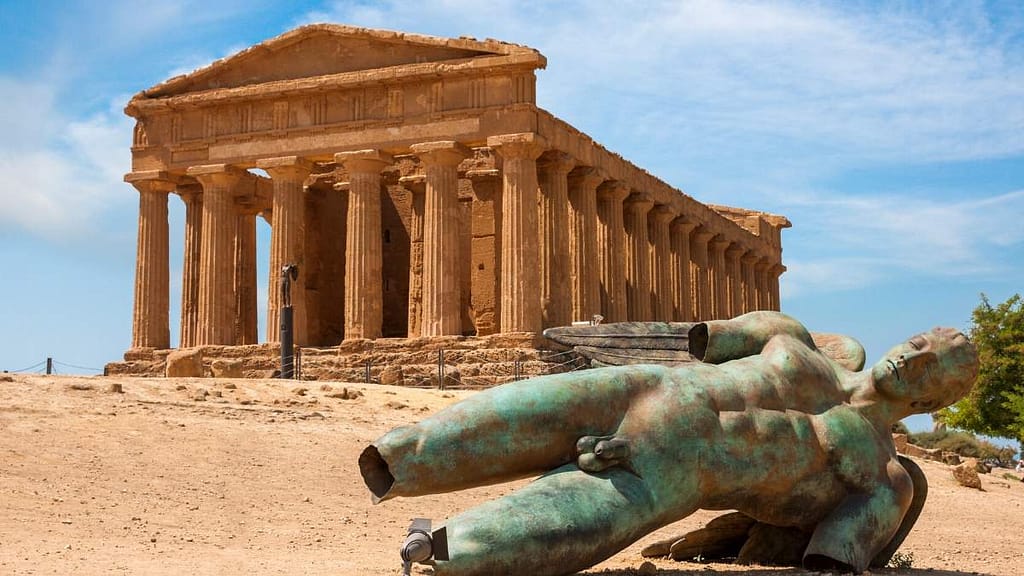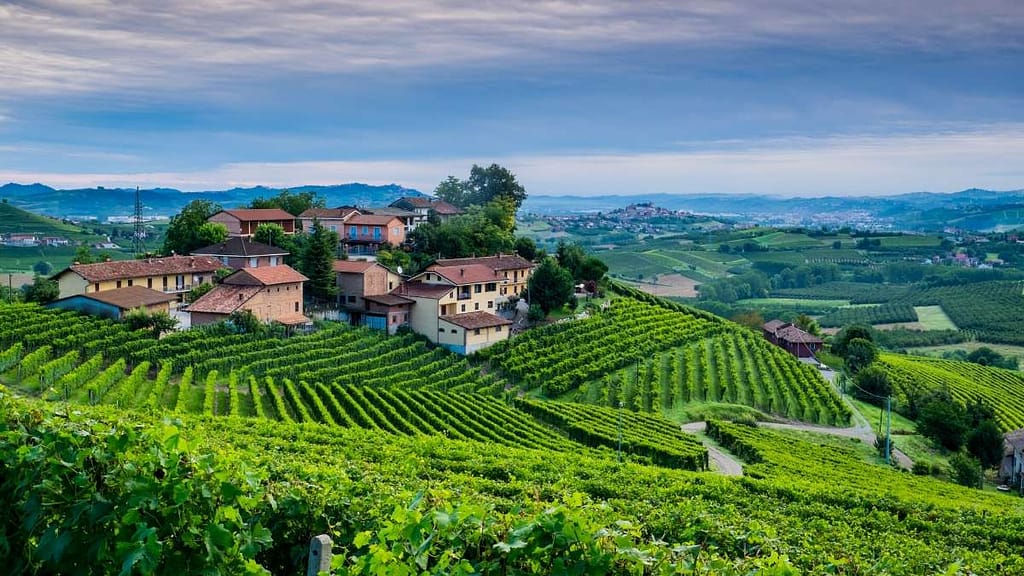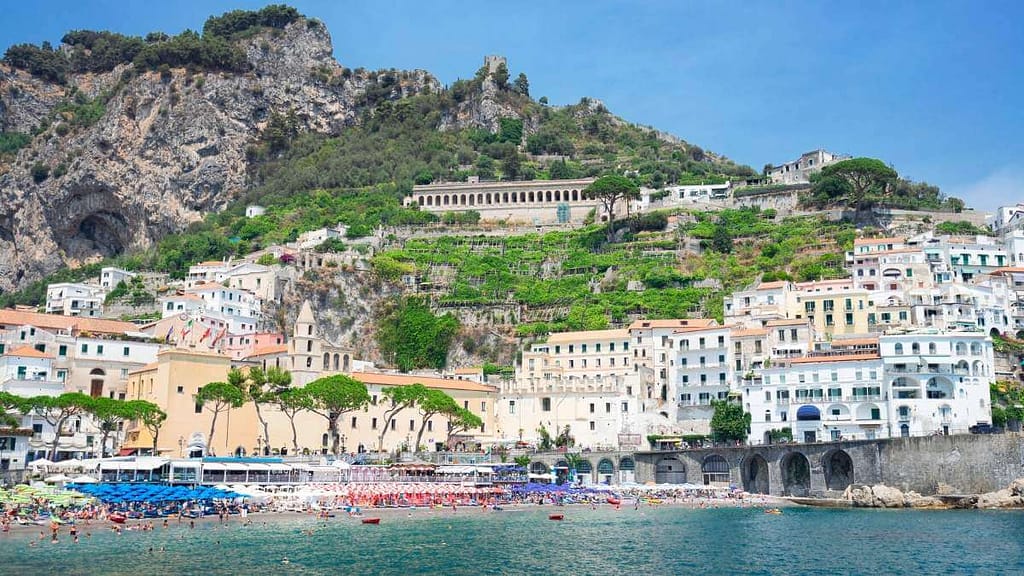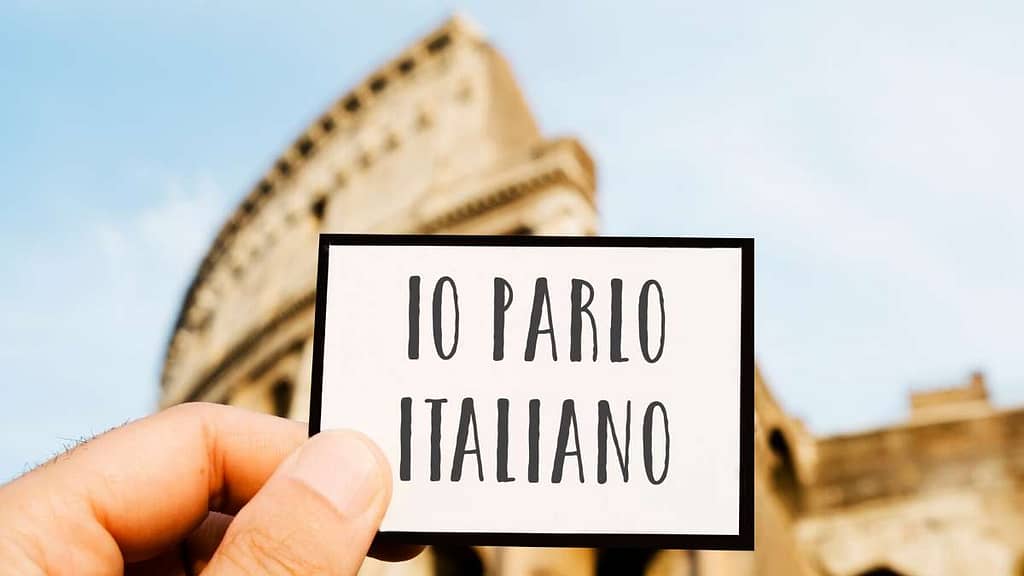When it comes down to it, you can pretty much throw a rock and hit some ruins anywhere in Italy. After all, this was the heart of the Roman Empire. The reality is that most of the ancient sites are now a pile of rubble. However, there are several remarkably well-preserved pre- and Roman ruins in Italy worth visiting. From underground markets to important monuments and even whole towns, these ancient sites offer an insight into the past.
This post may contain compensated links. Find out more info in our DISCLAIMER.
Roman ruins in Rome and area
Rome is full of history, art and culture. After all, it’s like an outdoor museum where you can walk through layers of history and touch the past. Here, you’ll find the most famous Roman ruins in Italy. As the city stands on top of ancient sites, you’ll find different architectural elements incorporated into other styles.
Note: There are ancient sites and Roman ruins in Italy almost everywhere. While it’s challenging to list them all, we’ve tried to include ones that are either well-preserved or substantial in size today. Let us know if there are any other ones you think we’ve missed and should be included!
As the once-beating heart of the Roman Empire, Rome is the best place to immerse yourself in the history and the legacy the ancient Romans left behind. While you can see elements of art and architecture from other centuries, there are several vital Roman ruins to see here.
The Colosseum
The Colosseum is one of my favourite of all Roman ruins. Initially, it was named the Flavian Amphitheatre and is a spectacular structure even today, considering it is over 2,000 years old. Begun by Emperor Vespasian in 72 AD, it held over 60,000 spectators, making it the largest amphitheatre ever built.
The bloodthirsty public enjoyed gladiator fights and battles with wild beasts. There were mock sea battles, hunts, and executions, resulting in many men and animals’ deaths over the years.

Vespasian commissioned the stadium on Nero’s opulent Domus Aurea site, determined to erase anything associated with the tyrant. His son, Titus, completed the project in 80 AD, with further modifications by Domitian between 81 and 96 AD. The three emperors were part of the Flavian dynasty, giving the Colosseum its original name. When it comes down to seeing Roman ruins in Italy, this is the place for that.
Arch of Constantine
Just outside the Colosseum stands the Arch of Constantine. It commemorates Emperor Constantine’s victory over co-emperor Maxentius in 312 AD. Although it is a bit of a Frankenstein, having elements recycled from other monuments, it is the largest surviving triumphal arch from the Roman Empire’s glory.

The arch is still an impressive sight at over 21 metres (69 feet) high and 25 metres (82 feet) wide. It’s the largest triumphant arch and one of the last monuments of Imperial Rome. As far as best Roman ruins go, this one seems intact.
The Roman Forum
The Forum was once the heart of Rome and the Roman Empire. It was the center of Roman life, with government buildings, temples and food stalls. In its glory, it was the home of the Senate House and the temple of Juno on Capitoline Hill, public spaces and even brothels.
The fact that there is anything left of the Forum is incredible. As you stroll by the site, you see the remnants of various temples, monuments, churches and other vital buildings where the empire once wielded its power. The Arch of Titus, the Curia, the Temple of Vesta, the Basilica Julia and the Temple of Antoninus and Faustina are some highlights that make the Roman Forum an impressive ancient site.

After the fall of the Roman Empire, the site was pillaged for building materials. Much of the marble and stone was used for other buildings, including the Vatican. From an Etruscan graveyard, then a Roman ceremonial centre turned pastureland, and an excavation site, the Forum is a testament to human ambition and determination.
PRO TIP: Book your priority access to the Colosseum, Roman Forum & Palatine Hill before you go and skip the line.
Palatine Hill
Once considered one of Rome’s most desirable addresses, Palatine Hill is where you’ll find some of the oldest ancient ruins. Here is also where Romulus supposedly founded the city of Rome. Interestingly, Palatine Hill is also where Emperor Augustus was born, and Emperor Caligula was assassinated.
Today, the once opulent Domus Flavia stands in ruins. However, both the Domus Augustana and the Domus Livia have some of the best-preserved frescoes from Roman times. Palatine Hill offers excellent views of the city and the Roman Forum below. As far as Roman ruins go, this one is significant for history lo
Domus Aurea
Nero’s famous Golden House was the epitome of luxury and excess. The scholars estimate it sat on over 300 acres (121 hectares) and was built in a record four years. It was a sight to behold with 155 rooms, roughly the size of three football fields, 12 metres (39 feet) high ceilings, and 30,000 square metres (323,000 square feet) of frescos and stuccoed ceilings.
The two-story villa had gold leaf overlay with embellishments of rare gems and seashells, thus the name Golden House. The stuccoed ceilings were adorned with semi-precious stones and ivory veneers. There was also an artificial lake that completed the vision.
Trajan’s markets
After Emperor Trajan conquered Dacia, modern-day Romania, he celebrated by building his forum in 107 AD. The complex was filled with storefronts, bars and shops. In the middle was Trajan’s column, flanked by two libraries. Both offered a closer view of the column, decorated with scenes from his conquest.

The main street of the forum is still intact. You can walk along the Via Biberatica and see the well-preserved remains of doorways of bars and restaurants. These Roman ruins show us that life in the ancient world wasn’t that different from ours. Book a personalized tour to explore this ancient market.
Teatro Marcello
At first glance, the Teatro Marcello might look like a missing part of the Colosseum, but it’s actually the older of the two. It was started by Julius Caesar and finished by Augustus, and likely inspired the Colosseum’s design. It became a fortified palace for the powerful Orsini family during the Renaissance. Today, the top floor consists of several apartments, while the Teatro serves as a backdrop for summer concerts. It is also one of my favourite Roman ruins in Rome today.

Pantheon
Standing at 43 metres (142 feet) wide and 43 metres (142 feet) high, the Pantheon is one of Ancient Rome’s best-preserved buildings. It hardly looks like the other Roman ruins in the city. Built around 125 AD on the site of two previous temples, it became a Catholic church around the 7th century AD. Today, it is the resting place of many noble Italians, including the artist Raphael.

Pantheon’s most impressive feature is the oculus, an 8-metre (27 feet) in diameter opening in the centre of the dome, and it’s the only source of natural light. The whole structure, built without metal rods, remains an engineering and architectural wonder. It is a perfect homage to Roman building prowess.
Baths of Caracalla
Even today, the size of what was one of Rome’s second-largest public thermal baths is enormous. This massive spa complex included three large water pools at different temperatures, two libraries, gymnasiums and gardens. This was a place for socializing, business and wellness. As houses didn’t have individual plumbing, most Romans went to the baths for sanitation, health, fitness and relaxation.

The Baths of Caracalla, named after the emperor behind the project, finished in 216 AD and could accommodate up to 1,600 people. A special aqueduct provided the much-needed freshwater for the pools. Additional reconstructions kept the spa going until it closed in 537 AD. These Roman baths ruins are a great example of the scale some of these ancient sites once were.
PRO TIP: Don’t miss the Circus Maximus just outside the baths. Once a Roman stadium for chariot races, today, it is a nice place to walk around, especially on a nice day, and imagine what it looked like in its glory.
Villa dei Quintili
Located on Rome’s outskirts, the Quintili Villa belonged to brothers Quintili, who served as consuls in 151 AD. The brothers, known for wealth, nobility and military prowess, died when Emperor Commodus accused them of treason and confiscated the villa after their execution.

The villa was an impressive feat of architecture and style. Its notable features included hot and cold water basins, 14-metre-high (46-foot) windows, courtyards and gardens. Located between the ancient Appian Way and the current Via Appia Nuova, the villa is now a museum. Also worth visiting are the nearby Roman aqueducts that used to provide water to the residents.
Underground Basilica of Porta Maggiore
The basilica, carved from volcanic tufa rock in the first century AD, was once home to an obscure cult called Neopythagoreanis. It was built over 2000 years ago by a wealthy Roman family of devotees and was accidentally discovered in 1917 during the construction of a railway line. After extensive renovations, it’s now open to the public. Inside are lavishly decorated ceilings with stucco reliefs of gods, animals and mythical creatures.

Piramide Cestia (The Pyramid of Caius Cestus)
While a pyramid might seem odd in Rome today, it was built when Romans were mad for everything Egyptian. They used several obelisks and pyramids to decorate monuments around the city. The construction of the marble-covered pyramid took 330 days. Sometime later, it was incorporated into the Aurelian Wall. After an extensive restoration, it’s now open to the public.

The pyramid of Cestius dates somewhere between 18 and 12 BC. It was a tomb for Caius Cestius, a man of power, wealth and influence. It’s the only surviving example of Roman pyramids. Pope Alexander VI dismantled the larger pyramid of Romulus during the 16th century to build the steps of St. Peter’s Basilica.
Archaeological Complex of Santa Croce in Gerusalemme
Just outside the old Aurelian walls of Rome is the church of the Holy Cross in Jerusalem. It is an archeological area of an imperial residence dating back to the late second and early third century AD. There are remnants of a theatre, extensive gardens and temples. Excavations and restorations unveiled several black and white mosaics and colourful frescoes.
Tempio Rotondo, Temple of Portunus and Bocca della Verita
Piazza dell Verita is like a jackpot for a blast from the Roman past. What was once a meat market is home to the Temple of Hercules, commonly called Tempio Rotondo (Round Temple) due to its shape and the Temple of Portunus. Both date back to the 2nd century BC and are made from Greek marble.

Here, you’ll also find the Bocca della Veritas (Mouth of Truth), an ancient Roman drain cover shaped like a giant face with an open mouth. According to the legend prevalent in Medieval times, the mouth would swallow a liar’s hand if placed in the opening.
For a complete list of ancient monuments in Rome, visit Wikipedia.
Tivoli – Villa Adriana (Hadrian’s Villa)
Tivoli was a retreat town for many wealthy Romans, including Emperor Hadrian, who built his country villa there around 117 AD. The peaceful setting and the proximity to numerous aqueducts made this a popular destination for wealthy people of the day.

Hadrian’s villa is a testament to the magnificence and grandeur of the Roman Empire. As a traveller and a keen architect, Hadrian drew inspiration for his villa from places in other parts of the world. Today, you can see the magnificent gardens, spas, and Teatro Marittimo (Maritime Theatre) remnants, an island where the emperor came seeking isolation.
Also impressive is the Canopus, an elongated lake surrounded by sculptures and columns, which is a copy of the sanctuary of Serapis near Alexandria. Take a guided tour of Hadrian’s Villa and the gardens of Villa D’Este in Tivoli.
Roman ruins of Ostia Antica
Rome’s ancient port city of Ostia was a thriving commercial hub and one of the empire’s most prosperous cities. Unlike Pompeii and Herculaneum, the other famous Roman ruins in Italy, Ostia wasn’t destroyed by a natural disaster. Threats of impending attacks by northern invaders and outbreaks forced the residents to abandon it during the 4th century AD.

The mud and silt deposits from the sea and the Tiber River preserved the city well, giving us an insight into Roman life. Villas, shops and theatres left behind provide a look into how the city functioned. Baths, temples and ossuaries tell us about the daily activities and beliefs of the ancients.
Roman ruins in and around Naples
While Naples might not immediately jump to mind when thinking of Roman ruins in Italy, there are many of them in this area. Naples, built on top of ancient ruins, is a treasure trove of history, as is the surrounding area. Many of these ancient sites are hidden under the modern city, making it even more fun to discover them.
Naples
There are many underground cisterns, tunnels and reservoirs under the city that date back to Greek and Roman times. Here you’ll find the remnants of the amphitheatre where Emperor Nero performed for audiences, a perfectly intact Roman market discovered under a church, as well as the Parco Archeologico Pausilypon. Built by Publio Vedio Pollio and gifted to Emperor Augustus, it’s an interesting place in Naples with fantastic views of the Bay of Naples.

Roman ruins of Pompeii
Pompeii is probably Italy’s most famous ancient Roman city and one of the largest ancient sites. Once a bustling and prosperous town, it disappeared for centuries under the ash and debris of the Vesuvius eruption in 79 AD. It lay forgotten until its rediscovery in the mid-1800s.


Pompeii provides us with a glimpse into the life of Romans who once lived there. The structures and objects left behind and even the food and drink remnants found on-site provide clues to the life of the ancients. It’s a massive site to explore and an opportunity to walk in the footsteps of Pompeiians who once lived here. Take a private walking tour with an archeologist for a more in-depth look at the city.
Roman ruins of Herculaneum
Perhaps not as well-known as Pompeii, Herculaneum suffered the same fate during the volcanic eruption of Mount Vesuvius and was covered in volcanic ash for centuries. The restoration and preservation efforts have ensured that it is well intact as it was excavated much later. The quality of the objects found here makes this site so interesting. Door frames, mosaic floors, furniture and even rooftops have survived the disaster.


Unlike Pompeii, you can get closer to the mosaics and frescoes and walk into what were once houses. Overlooking the site is modern-day Herculaneum, which makes you wonder how those living above it feel about their own mortality. Parts of the ancient city remain under the existing one, but what has been uncovered is worth visiting.
Benevento
Benevento is home to an exceptionally well-preserved Roman amphitheatre built by Emperor Hadrian in the 2nd century AD. It was used for plays and could hold between 10,000 and 15,000 spectators. Today, you can explore the stands and the stage and even wander through the same corridors ancient spectators once did.
@amongstromans If you’re into ancient ruins like me, you have to check out the Roman theatre in Benevento! Located in the Campania region, this mind-blowing amphitheater was built by Emperor Hadrian in the 2nd century AD. ?? ? The theatre was used for plays and could hold between 10,000 and 15,000 spectators. Today, you can explore the stands and the stage and even wander through the same corridors ancient spectators once did. Benvento’s Roman Amphitheatre is a must-see destination that will take you to a different time.? ? Save this post for later, and add Benevento to your next Italian itinerary! ? #CapCut #HiddenGem #italyadventures #discoveritalywithme #campania #fyp #historybuff #TravelItaly #italytiktok #benevento #campaniadavivere
? Città vuota – Mina
Scavi di Stabia (Stabiae)
Stabia was another Roman seaside city with large villas for the wealthy. Although nearby Pompeii overshadowed it in antiquity, it suffered the same fate in 79 AD. Rediscovered initially in the mid-1800s, it had to wait until the 1950s for excavation and restoration efforts. You can explore two villas, some of the finest examples of Roman villas today.
Parco Archeologico di Cuma (Cumae Archaeological Site)
What started as the first Greek colony on mainland Italy in the 8th century B.C. later became a rich Roman city. Here, you’ll find remnants of temples dedicated to Apollo, Diana and Isis, as well as the Crypta Romana and the enormous Grotta di Cocceio, a tunnel large enough for chariots to pass through the mountain to reach the lake.

You can also tour the triangular Cave of the Sibyl (Antro della Sibilla). This is where the Cumaean Sibyl, priestess of Apollo, sang her prophecies or wrote them on leaves from oak trees for centuries. She has also appeared in many literary works of Virgil, Ovid, Dante and TS Elliott.
Pozzuoli and Rione Terra
Pozzuoli, another Roman city with Greek origins, is home to the Amphitheatrum Flavium (Flavio Amphitheater) and the Macellum of Pozzuoli, also known as the Temple of Serapis. The amphitheatre is the third-largest after the Colosseum and the Capuan Amphitheater. The temple, actually a marketplace in ancient times, includes three marble columns built between the 1st and 2nd century AD.

Another great underground city of Rione Terra is a step back in time. Preserved intact under the modern-day town, this once-important Roman colony of Puteoli dates back to 194 BC. Discovered by chance in 1980 due to volcanic activity, it offers a glimpse into the life of Romans. Stroll along the ancient road lined with shop fronts, warehouses and homes.
Capua
Called Casilinum in antiquity, the ancient city of Capua dates back to 600 BC. Etruscan, in origin, became a self-governing community under Roman rule until it sided with Carthage against Rome and lost its political rights. While famous for its bronzes and perfumes, Capua is also where Spartacus began a revolt in 73 BC. Take a guided tour to explore the remains of the second-largest Roman theatre, where he fought as a gladiator, as well as temples, baths and tombs.

Parco Archeologico di Baia
Once a luxury resort town catering to the wealthy and prominent Romans, today, Baia lies underwater. The natural volcanic vents that made baths and spas here so popular and successful,l combined with the seismic activity, led to flooding. You can explore the city by boat or dive for a closer look.

Other ancient sites in Italy
You can find many ancient sites and Roman ruins in Italy. Some are less concentrated in a particular area and deserve a stand-alone mention. Many more have yet to be discovered, while others are under excavation today. The beauty of ruins is that with careful excavations and preservations, they give us a glimpse into the past. In Italy, you can spend years visiting them all.
Roman ruins in Verona
Probably most famous for the Romeo and Juliet ill-fated romance, here you’ll also find a Roman amphitheatre dating back to 30 AD. In ancient times, the venue held over 30,000 spectators from all over the world. Originally made of pink and white limestone, it is the third-largest of its kind in Italy. Today, it’s used for performances for thousands of spectators.

Foro Romano of Assisi (Perugia)
Linked closer to St. Francis of Assisi’s medieval figure, ancient Assisi was a Roman town with military purposes. Here, you’ll find a partially excavated Roman forum and the well-preserved Roman temple of Minerva, dating back to the 1st century BC.

Paestum
Paestum, a once-prosperous city, dates back to the 7th century BC. Settled first by the Greeks, it enjoyed over 1,000 years of prosperity, including the Lucanian and Roman rule. Abandoned after the fall of the Roman Empire, the fields turned into overgrown swamps.

Three intact ancient Greek temples were accidentally rediscovered in the 18th century during the construction of a nearby road. Additional temples, walls, tombs and a theatre were discovered in the 20th century. While they are not precisely Roman ruins, they are still spectacular ancient sites.
Valley of the Temples (Sicily)
Declared a UNESCO World Heritage Site, the Archaeological and Landscape Park of the Valley of the Temples includes ruins of the ancient city Akragas, named after a river of the same name. It was one of the most important Greek colonies in Sicily, founded around 582 BC. Today, the site covers over 1,300 hectares (over 3,000 acres) and is the largest archeological site in the world. It is home to several Doric temples and magnificent views.

Tarquinia
Tarquinia, Tarchuna in Etruscan, emerged as a trading power in the 8th century BC. Only a little is known about the city throughout the Roman period, but you can learn more about its Etruscan heritage by visiting the necropolis of Monterozzi.

The cemetery predates the Romans and is home to over 6,000 tombs, some of which have beautiful wall paintings of exceptional quality. They provide an insight into the secretive world of the Etruscans. Visit the nearby National Museum of Cerveteri and check out the numerous Etruscan artifacts.
Taormina (Sicily)
Settled on the picturesque hill of Monte Tauro, Taormina views of the bays below and Mount Etna have attracted people here for centuries. Settled by the Sicels, Greeks and Romans, then the Byzantines, Saracens, Arabs, Normans and Spaniards, Taormina has a lot of history. Here, you’ll find the remnants of an ancient Greek theatre with Roman modifications, where gladiators entertained audiences, and numerous fragments of ancient buildings.

Barumini (Sardinia)
A UNESCO World Heritage Site, Barumini is home to the archaeological site “Su Nuraxi.” It is the most complete and best-preserved example of the Nuraghi architecture, Sardinia’s oldest civilization dating back to the Bronze Age (11th-10th centuries BC.). Not much is known about these cylindrical structures made of basalt blocks. A museum and a complex of huts, cisterns, bastions and towers offer a look as far back as the 16th century BC.

Final thoughts on Roman ruins in Italy
Italy is a history lover’s dream. The layers of the past make up the country, so many love to visit. Whether it’s the Roman ruins or other ancient sites, there is much to see and cover. While you will most likely come across the past anywhere in the country, this post is meant to guide those who want a handy overview.
Many Roman ruins in Italy haven’t been covered here, as that would be impossible to capture in one post. However, the Romans were a conquering bunch, and you can find other Roman ruins in other countries outside of Italy. They capture the extent of how far-reaching the Roman Empire was and how enduring Roman architecture is today. So, make sure to visit some of these places on your next trip to Italy.





